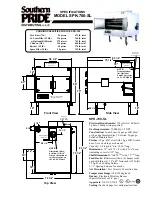
GOLDBERG AND MÄKIVIRTA
AUTOMATED IN-SITU EQUALISATION
AES 23RD CONFERENCE, May 23-25, 2003
8
Table 12. Use of available room response controls.
Room Response Control
Usage vs.
availability
% Usage
Midrange Level
27/33
82%
Treble Level
22/33
67%
Bass Tilt
37/67
55%
Treble Tilt
11/37
30%
Bass Level
8/33
24%
Bass Roll-off
10/67
15%
Appendix D gives the quartile difference and RMS
deviations for each loudspeaker in the study, for the
broadband and each subband. The quartile difference
or RMS deviation after equalisation is subtracted from
the same before equalisation. An improvement will
produce a negative value of difference. Both the quar-
tile difference and RMS deviation values represent
two slightly different ways to look at the deviation
from the median value of the distribution. The quartile
limits are more robust to outlier values while the RMS
values include these effects.
For small two-way systems (Figure 9-10), the main
improvement is seen at low frequencies in four out of
12 cases. In only one case is there is a significant im-
provement in the broadband flatness.
The broadband flatness of the two-way systems is im-
proved in four (quartile data, Figure 11) or eight
(RMS data, Figure 12) cases out of 22. An equal
number of reductions and increases of low frequency
quartile values can be seen. MF subband quartile val-
ues improve in one case and deteriorate in 5 cases and
there are no changes in the HF subband. The flatness
in the broadband and LF subband of the RMS devia-
tion data has improved indicating a reduction of out-
lier values. The MF and HF subbands show no
changes or a slight increase of the RMS deviation.
Three-way systems show a clear reduction in most
cases of both the quartile difference (Figure 13) and
RMS deviation (Figure 14) for the broadband and LF
subband. Slight, and equal numbers of, increases and
reductions are seen for MF and HF subbands.
A similar trend is seen for the three large systems in-
cluded in this study (Figure 15-16). Mainly the LF
subband flatness is improved and this is also reflected
in the broadband improvement.
Some of the responses appeared to become worse in
the quartile difference and RMS deviation in the sub-
band analysis. This was not reflected in the broadband
metrics, which indicates that the arbitrary
subband fre-
quency division introduced some of the error. Also,
the cases where this happened suffered from severe
anomalies within the pre-equalisation response due to
extremely bad room acoustic conditions. The equalisa-
tion was not designed to compensate for this.
Subband Median Levels - Small models
-3
-2
-1
0
1
2
3
4
5
LF
MF
HF
LF
MF
HF
Original
Equalised
Level, dB
Subband Median Levels - 2-way models
-3
-2
-1
0
1
2
3
4
5
LF
MF
HF
LF
MF
HF
Original
Equalised
Level, dB
Subband Median Levels - 3-way models
-3
-2
-1
0
1
2
3
4
5
LF
MF
HF
LF
MF
HF
Original
Equalised
Level, dB
Subband Median Levels - All Models
-3
-2
-1
0
1
2
3
4
5
LF
MF
HF
LF
MF
HF
Original
Equalised
Level, dB
Figure 3. Mean and standard deviation of subband median levels before and after equalisation.
The subband median levels (Figure 3) illustrate the
broadband frequency balance between the subbands.
Loudspeaker loading from nearby boundaries is re-
flected in the LF subband median level before equali-
sation, especially in the often flush mounted three-
way models. The median level in the LF subband is









































